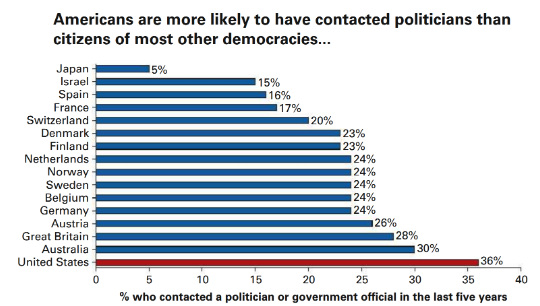
Unit 4 - Chapter 6
THE AMERICAN PEOPLE
Public Opinion: The distribution of the population’s beliefs about politics and policy issues.
The study of American public opinion aims to understand the distribution of the population’s beliefs about politics and policy issues.
Measuring public opinion involves painstaking interviewing procedures and careful wording of questions.
One way of looking at the American public is through demography—the science of human populations. The most valuable tool for understanding demographic changes in America is the Census.
Census: An “actual enumeration” of the population, which the Constitution requires that the government conduct every 10 years. The Census is a valuable tool for understanding demographic changes.
The information determines how more than $400 billion of federal funding is allocated every year for infrastructure and services such as hospitals, schools, and job training centers.
THE IMMIGRATION SOCIETY
All Americans except Native Americans are descended from immigrants or are immigrants themselves.
Wave 1: Immigrants were mainly northwestern Europeans (English, Irish, Germans, and Scandinavians).
Wave 2: Many immigrants were southern and eastern Europeans (Italians, Jews, Poles,
Russians, and others).
Wave 3: Immigrants have been dominated by Latinos, particularly from Cuba, Central America, and Mexico, and Asians from Vietnam, Korea, the Philippines, and elsewhere.
In today’s interconnected world, migration from one country to another is easier than ever before, and sticks that attract immigrants with valuable skills can improve their economic status. Thus, a country’s immigration policy, which sets criteria for admitting people from abroad for permanent residence, can be a valuable economic tool—if a country so chooses. Some people think the United States needs to put economic factors further up on its list of priorities for immigrants
Immigrants to the United States can be roughly classified into three categories: (1) family-sponsored, (2) employment-sponsored, and (3) refugees and political asylum seekers.
THE AMERICAN MELTING POT
Melting Pot: A term often used to characterize the United States, with its history of immigration and mixing of cultures, ideas, and peoples.
Majority Minority: The situation, likely beginning in the mid-twentieth century, in which non-Hispanic whites will represent a minority of the U.S. population and minority groups together will represent a majority.
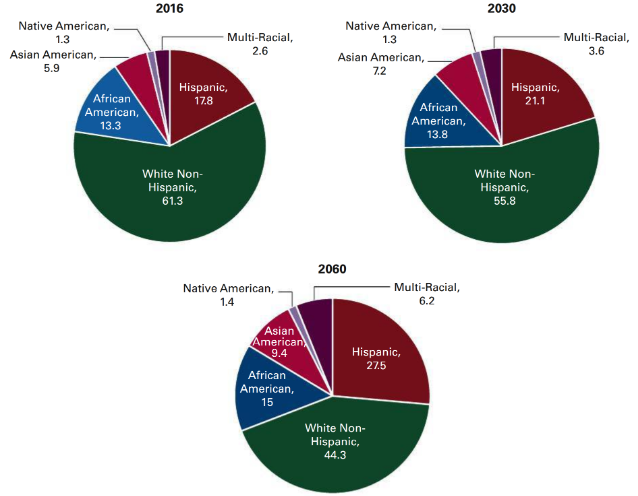
Based on current birth and immigration rates, the Census Bureau estimates that the demographics of the United States should change as shown in the accompanying pie graphs. As of 2020, the Census estimated that minority groups should be in the majority for the nation as a whole sometime around the year 2045. Of course, should rates of birth and immigration change, so would these estimates.
Regardless of ethnic background, Americans have a common political culture—an overall set of values widely shared within the society.
There is much agreement across ethnic groups about such basic American values as the principle of treating all equally.
THE REGIONAL SHIFT
Reapportionment: The process of reallocating seats in the House of Representatives every 10 years on the basis of the results of the Census.
Demographic changes are associated with political changes. States gain or lose
congressional representation as their population changes, and thus power shifts as well.
HOW AMERICANS LEARN ABOUT POLITICS: POLITICAL SOCIALIZATION
Political Socialization: The process through which an individual acquires political attitudes, views, and knowledge from, among other sources, family, the media, and school.
THE PROCESS OF POLITICAL SOCIALIZATION
Formal Learning: In-class learning about politics
Informal Learning: Mostly accidental socialization about politics
The family, the media, and the schools all serve as important agents of political socialization.
Family: Children often pick up their political leanings from the attitudes of their
parents.
Media: Many studies have attributed the relative lack of political knowledge of today’s youth to their media consumption or, more appropriately, to their lack of it
School: Governments, including our own, often use schools to promote national loyalty
and support for their basic values.
In the 2018 congressional elections, as in most midterm elections, the relationship between age and turnout was particularly pronounced, as you can see in this figure. Because today’s young adults lean in the liberal direction, political analysts concluded that the relatively low turnout rate of young people cost the Democrats a substantial number of seats in the House and Senate in 2018.
MEASURING PUBLIC OPINION AND POLITICAL INFORMATION
The study of American public opinion aims to understand the population’s beliefs about politics and policy issues.
Polls rely on a sample of the population—a relatively small proportion of people who are chosen to represent the whole.
The key to the accuracy of opinion polls is the technique of random sampling, which operates on the principle that everyone should have an equal probability of being selected as part of the sample.
The level of confidence is known as the sampling error, which depends on the size of the sample.
The more people interviewed, the more confident one can be of the results.
Polls help political candidates detect public preferences. Supporters of polling insist that it is a tool for democracy. With it, they say, policymakers can keep in touch with changing opinions on the issues. Yet polls might weaken democracy in another way—they may distort the electoral process by focusing on who is ahead more than on what people think about public policy questions.
Exit Poll: Public opinion surveys used by major media pollsters to predict electoral winners with speed and precision. It makes people wonder whether their votes matter at all.
TV networks respond that it is their job to report winners and losers as soon as technologically possible. Furthermore, they argue that exit polls also enable them to immediately report what sorts of groups have voted which way and for what particular reasons.
Computer and telephone technology has also made surveying less expensive and more commonplace.
Random-Digit Sampling: A technique used by pollsters to place telephone calls randomly to both listed and unlisted numbers when conducting a survey.
Disadvantages: A small percentage of the population does not have a phone, and people are substantially less willing to participate over the telephone than in person
HOW POLITICAL KNOWLEDGE VARIES ACCORDING TO DEMOGRAPHIC AND POLITICAL FACTORS
Demographic differences explain a lot of the variation in political knowledge, as you can see in the figure below. In contrast, political differences generally do not predict differences in political knowledge nearly as well as demographics.
Ever since the beginning of survey research in the 1930s, pollsters have regularly found that the level of public information about political issues is often quite low.
WHY IT MATTERS TODAY - POLITICAL KNOWLEDGE OF THE ELECTORATE
The average American clearly has less political information than most analysts consider to be desirable. While this level of information is surely adequate to maintain our democracy, survey data plainly show that citizens with above-average levels of political knowledge are more likely to vote and to have stable and consistent opinions on policy issues. If political knowledge were to increase overall, it would in all likelihood be good for American democracy.
THE DECLINE OF TRUST IN THE AMERICAN GOVERNMENT - 1958-2019
This graph shows how people have responded over time to the following question: How much of the time do you think you can trust the government in Washington to do what is right—just about always, most of the time, or only some of the time?
WHAT AMERICANS VALUE: POLITICAL IDEOLOGIES
Political Ideology: A coherent set of beliefs about politics, public policy, and public purpose, which helps give meaning to political events.
Liberal ideology supports a wide scope for the central government, often involving policies that aim to promote equality.
Conservative ideology supports a less active scope of the government that gives free rein to the private sector.
Decades of survey data have consistently shown that more Americans choose the
ideological label of conservative over liberal.
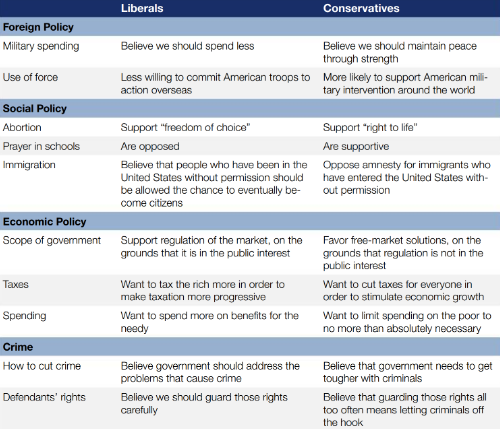 Issues concerning the priorities of government lead women to be significantly less conservative than men.
Issues concerning the priorities of government lead women to be significantly less conservative than men.
This ideological difference between men and women has resulted in the gender gap, a regular pattern in which women are more likely to support Democratic candidates.
THE INFLUENCE OF POLITICAL IDEOLOGY ON POLITICAL BEHAVIOR
DIFFERENCES IN AMERICAN VOTERS’ LEVEL OF POLITICAL CONCEPTUALIZATION. 1956-2016
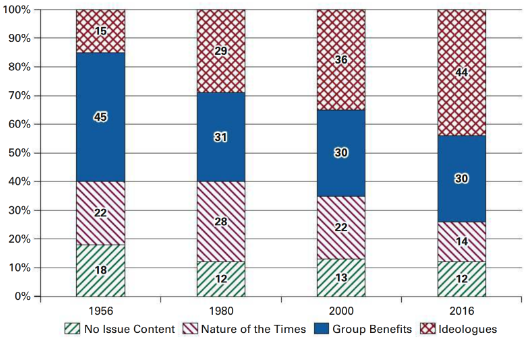 HOW AMERICANS PARTICIPATE IN POLITICS
HOW AMERICANS PARTICIPATE IN POLITICS
Political Participation: All the activities used by citizens to influence the selection of political leaders or the policies they pursue. The most common means of political participation in a democracy is voting; other means include contacting public officials, protest, and civil disobedience.
Conventional participation: includes many widely accepted modes of influencing government voting, trying to persuade others, ringing doorbells for a petition, running for office
Unconventional participation: Includes activities that are often dramatic, such as
protesting, civil disobedience, and even violence
POLITICAL PARTICIPATION OTHER THAN VOTING
The graph below shows the results from these three surveys over a 47-year period, demonstrating that political participation in America has generally increased over time.
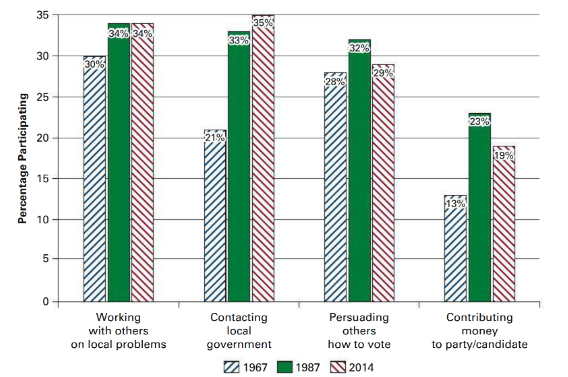 Protest: A form of political participation designed to achieve policy change through dramatic and unconventional tactics.
Protest: A form of political participation designed to achieve policy change through dramatic and unconventional tactics.
Civil Disobedience: A form of political participation based on a conscious decision to break a law believed to be unjust and to suffer the consequences.
Can be violent
CONVENTIONAL AND UNCONVENTIONAL POLITICAL PARTICIPATION
In a 2014 cross-national survey of political behavior in 16 established democracies, citizens were asked whether they had engaged in a variety of forms of political participation. Whereas Americans were among the most likely to engage in the conventional mode of contacting politicians, they were among the least likely to engage in protest demonstrations.
• Do you think the fact that Americans are usually more likely to contact politicians than to protest is a good sign for American democracy, showing that people are largely content with conventional channels of transmitting public opinion to policymakers?
• Do you think that when many people engage in political protest, this indicates that citizens are frustrated and discontented with their government, or is it likely just a reflection of political passion and involvement?
Americans are just more likely to employ conventional political participation—contacting politicians and/or governmental officials—than they are to engage in protests.
WHY IT MATTERS TODAY - POLITICAL PARTICIPATION
Inequality in political participation is a problem in a representative democracy. Public policy debates and outcomes would probably be substantially different if people of all age groups and income levels participated equally. If young adults participated more, politicians might be more inclined to seek ways by which the government could help young people get the training necessary to obtain good jobs in a changing economy. And if poor people participated at higher levels, government programs to alleviate poverty would likely be higher on the political agenda.
Unit 4 - Chapter 6
THE AMERICAN PEOPLE
Public Opinion: The distribution of the population’s beliefs about politics and policy issues.
The study of American public opinion aims to understand the distribution of the population’s beliefs about politics and policy issues.
Measuring public opinion involves painstaking interviewing procedures and careful wording of questions.
One way of looking at the American public is through demography—the science of human populations. The most valuable tool for understanding demographic changes in America is the Census.
Census: An “actual enumeration” of the population, which the Constitution requires that the government conduct every 10 years. The Census is a valuable tool for understanding demographic changes.
The information determines how more than $400 billion of federal funding is allocated every year for infrastructure and services such as hospitals, schools, and job training centers.
THE IMMIGRATION SOCIETY
All Americans except Native Americans are descended from immigrants or are immigrants themselves.
Wave 1: Immigrants were mainly northwestern Europeans (English, Irish, Germans, and Scandinavians).
Wave 2: Many immigrants were southern and eastern Europeans (Italians, Jews, Poles,
Russians, and others).
Wave 3: Immigrants have been dominated by Latinos, particularly from Cuba, Central America, and Mexico, and Asians from Vietnam, Korea, the Philippines, and elsewhere.
In today’s interconnected world, migration from one country to another is easier than ever before, and sticks that attract immigrants with valuable skills can improve their economic status. Thus, a country’s immigration policy, which sets criteria for admitting people from abroad for permanent residence, can be a valuable economic tool—if a country so chooses. Some people think the United States needs to put economic factors further up on its list of priorities for immigrants
Immigrants to the United States can be roughly classified into three categories: (1) family-sponsored, (2) employment-sponsored, and (3) refugees and political asylum seekers.
THE AMERICAN MELTING POT
Melting Pot: A term often used to characterize the United States, with its history of immigration and mixing of cultures, ideas, and peoples.
Majority Minority: The situation, likely beginning in the mid-twentieth century, in which non-Hispanic whites will represent a minority of the U.S. population and minority groups together will represent a majority.

Based on current birth and immigration rates, the Census Bureau estimates that the demographics of the United States should change as shown in the accompanying pie graphs. As of 2020, the Census estimated that minority groups should be in the majority for the nation as a whole sometime around the year 2045. Of course, should rates of birth and immigration change, so would these estimates.
Regardless of ethnic background, Americans have a common political culture—an overall set of values widely shared within the society.
There is much agreement across ethnic groups about such basic American values as the principle of treating all equally.
THE REGIONAL SHIFT
Reapportionment: The process of reallocating seats in the House of Representatives every 10 years on the basis of the results of the Census.
Demographic changes are associated with political changes. States gain or lose
congressional representation as their population changes, and thus power shifts as well.
HOW AMERICANS LEARN ABOUT POLITICS: POLITICAL SOCIALIZATION
Political Socialization: The process through which an individual acquires political attitudes, views, and knowledge from, among other sources, family, the media, and school.
THE PROCESS OF POLITICAL SOCIALIZATION
Formal Learning: In-class learning about politics
Informal Learning: Mostly accidental socialization about politics
The family, the media, and the schools all serve as important agents of political socialization.
Family: Children often pick up their political leanings from the attitudes of their
parents.
Media: Many studies have attributed the relative lack of political knowledge of today’s youth to their media consumption or, more appropriately, to their lack of it
School: Governments, including our own, often use schools to promote national loyalty
and support for their basic values.
In the 2018 congressional elections, as in most midterm elections, the relationship between age and turnout was particularly pronounced, as you can see in this figure. Because today’s young adults lean in the liberal direction, political analysts concluded that the relatively low turnout rate of young people cost the Democrats a substantial number of seats in the House and Senate in 2018.
MEASURING PUBLIC OPINION AND POLITICAL INFORMATION
The study of American public opinion aims to understand the population’s beliefs about politics and policy issues.
Polls rely on a sample of the population—a relatively small proportion of people who are chosen to represent the whole.
The key to the accuracy of opinion polls is the technique of random sampling, which operates on the principle that everyone should have an equal probability of being selected as part of the sample.
The level of confidence is known as the sampling error, which depends on the size of the sample.
The more people interviewed, the more confident one can be of the results.
Polls help political candidates detect public preferences. Supporters of polling insist that it is a tool for democracy. With it, they say, policymakers can keep in touch with changing opinions on the issues. Yet polls might weaken democracy in another way—they may distort the electoral process by focusing on who is ahead more than on what people think about public policy questions.
Exit Poll: Public opinion surveys used by major media pollsters to predict electoral winners with speed and precision. It makes people wonder whether their votes matter at all.
TV networks respond that it is their job to report winners and losers as soon as technologically possible. Furthermore, they argue that exit polls also enable them to immediately report what sorts of groups have voted which way and for what particular reasons.
Computer and telephone technology has also made surveying less expensive and more commonplace.
Random-Digit Sampling: A technique used by pollsters to place telephone calls randomly to both listed and unlisted numbers when conducting a survey.
Disadvantages: A small percentage of the population does not have a phone, and people are substantially less willing to participate over the telephone than in person
HOW POLITICAL KNOWLEDGE VARIES ACCORDING TO DEMOGRAPHIC AND POLITICAL FACTORS
Demographic differences explain a lot of the variation in political knowledge, as you can see in the figure below. In contrast, political differences generally do not predict differences in political knowledge nearly as well as demographics.
Ever since the beginning of survey research in the 1930s, pollsters have regularly found that the level of public information about political issues is often quite low.
WHY IT MATTERS TODAY - POLITICAL KNOWLEDGE OF THE ELECTORATE
The average American clearly has less political information than most analysts consider to be desirable. While this level of information is surely adequate to maintain our democracy, survey data plainly show that citizens with above-average levels of political knowledge are more likely to vote and to have stable and consistent opinions on policy issues. If political knowledge were to increase overall, it would in all likelihood be good for American democracy.
THE DECLINE OF TRUST IN THE AMERICAN GOVERNMENT - 1958-2019
This graph shows how people have responded over time to the following question: How much of the time do you think you can trust the government in Washington to do what is right—just about always, most of the time, or only some of the time?
WHAT AMERICANS VALUE: POLITICAL IDEOLOGIES
Political Ideology: A coherent set of beliefs about politics, public policy, and public purpose, which helps give meaning to political events.
Liberal ideology supports a wide scope for the central government, often involving policies that aim to promote equality.
Conservative ideology supports a less active scope of the government that gives free rein to the private sector.
Decades of survey data have consistently shown that more Americans choose the
ideological label of conservative over liberal.
 Issues concerning the priorities of government lead women to be significantly less conservative than men.
Issues concerning the priorities of government lead women to be significantly less conservative than men.
This ideological difference between men and women has resulted in the gender gap, a regular pattern in which women are more likely to support Democratic candidates.
THE INFLUENCE OF POLITICAL IDEOLOGY ON POLITICAL BEHAVIOR
DIFFERENCES IN AMERICAN VOTERS’ LEVEL OF POLITICAL CONCEPTUALIZATION. 1956-2016
 HOW AMERICANS PARTICIPATE IN POLITICS
HOW AMERICANS PARTICIPATE IN POLITICS
Political Participation: All the activities used by citizens to influence the selection of political leaders or the policies they pursue. The most common means of political participation in a democracy is voting; other means include contacting public officials, protest, and civil disobedience.
Conventional participation: includes many widely accepted modes of influencing government voting, trying to persuade others, ringing doorbells for a petition, running for office
Unconventional participation: Includes activities that are often dramatic, such as
protesting, civil disobedience, and even violence
POLITICAL PARTICIPATION OTHER THAN VOTING
The graph below shows the results from these three surveys over a 47-year period, demonstrating that political participation in America has generally increased over time.
 Protest: A form of political participation designed to achieve policy change through dramatic and unconventional tactics.
Protest: A form of political participation designed to achieve policy change through dramatic and unconventional tactics.
Civil Disobedience: A form of political participation based on a conscious decision to break a law believed to be unjust and to suffer the consequences.
Can be violent
CONVENTIONAL AND UNCONVENTIONAL POLITICAL PARTICIPATION
In a 2014 cross-national survey of political behavior in 16 established democracies, citizens were asked whether they had engaged in a variety of forms of political participation. Whereas Americans were among the most likely to engage in the conventional mode of contacting politicians, they were among the least likely to engage in protest demonstrations.
• Do you think the fact that Americans are usually more likely to contact politicians than to protest is a good sign for American democracy, showing that people are largely content with conventional channels of transmitting public opinion to policymakers?
• Do you think that when many people engage in political protest, this indicates that citizens are frustrated and discontented with their government, or is it likely just a reflection of political passion and involvement?
Americans are just more likely to employ conventional political participation—contacting politicians and/or governmental officials—than they are to engage in protests.
WHY IT MATTERS TODAY - POLITICAL PARTICIPATION
Inequality in political participation is a problem in a representative democracy. Public policy debates and outcomes would probably be substantially different if people of all age groups and income levels participated equally. If young adults participated more, politicians might be more inclined to seek ways by which the government could help young people get the training necessary to obtain good jobs in a changing economy. And if poor people participated at higher levels, government programs to alleviate poverty would likely be higher on the political agenda.
 Knowt
Knowt